-
Countries
-
Data and Analysis
-
Special Focus
-
Crisis Responses
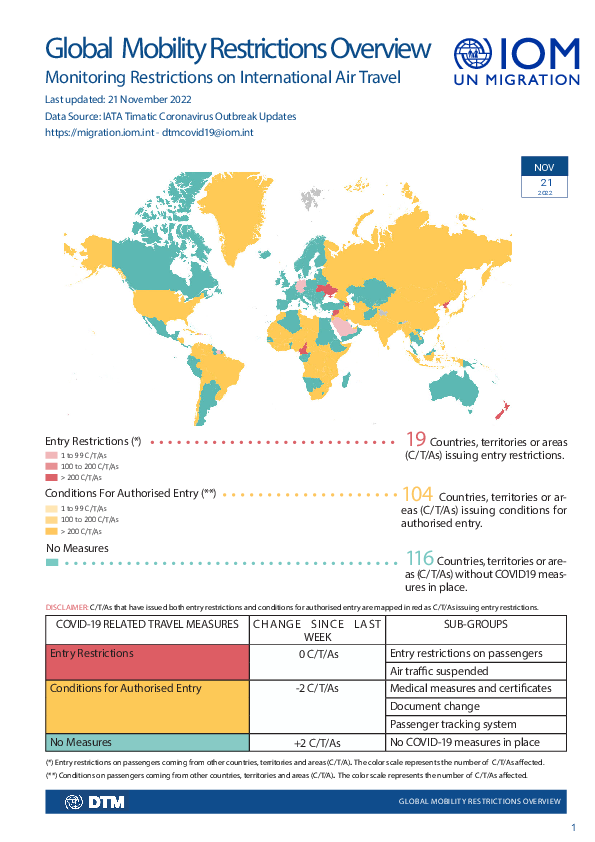
Contact
DTMcovid19@iom.int
Language
English
Location
Global
Period Covered
Nov 14 2022
Nov 21 2022
Activity
- Other
The DTM Global Mobility Restrictions Overview provides updates on international air travel restrictions and conditions for authorized entry. This overview aims to understand how COVID-19 has impacted human mobility, detailing how global and regional trends in air travel measures have evolved since COVID-19 was declared a global pandemic in March 2020. The data presented focuses on the changes in public health-related immigration and border management measures. It provides information intended to support IOM missions and partners in targeted response planning and advocacy for vulnerable populations who may be affected by changes in global mobility.
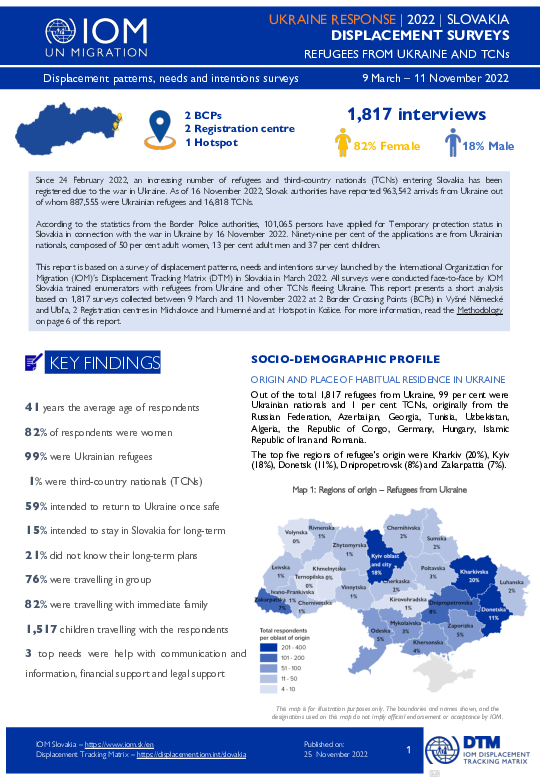
Contact
DTM Europe, DTMMediterranean@iom.int
Language
English
Location
Slovakia
Period Covered
Mar 09 2022
Nov 11 2022
Activity
- Survey
Since 24 February 2022, an increasing number of refugees and third-country nationals (TCNs) entering Slovakia has been registered due to the war in Ukraine. As of 16 November 2022, Slovak authorities have reported 963,542 arrivals from Ukraine out of whom 887,555 were Ukrainian refugees and 16,818 TCNs.
According to the statistics from the Border Police authorities, 101,065 persons have applied for Temporary protection status in Slovakia in connection with the war in Ukraine by 16 November 2022. Ninety-nine per cent of the applications are from Ukrainian nationals, composed of 50 per cent adult women, 13 per cent adult men and 37 per cent children.
This report is based on a survey of displacement patterns, needs and intentions survey launched by the International Organization for Migration (IOM)’sDisplacement Tracking Matrix (DTM) in Slovakia in March 2022. All surveys were conducted face-to-face by IOM Slovakia trained enumerators with refugees from Ukraine and other TCNs fleeing Ukraine. This report presents a short analysis based on 1,817 surveys collected between 9 March and 11 November 2022 at 2 Border Crossing Points (BCPs) in Vyšné Německé and Ubl'a, 2 Registration centres in Michalovce and Humenné and at Hotspot in Košice. For more information, read the Methodology on page 6 of this report.
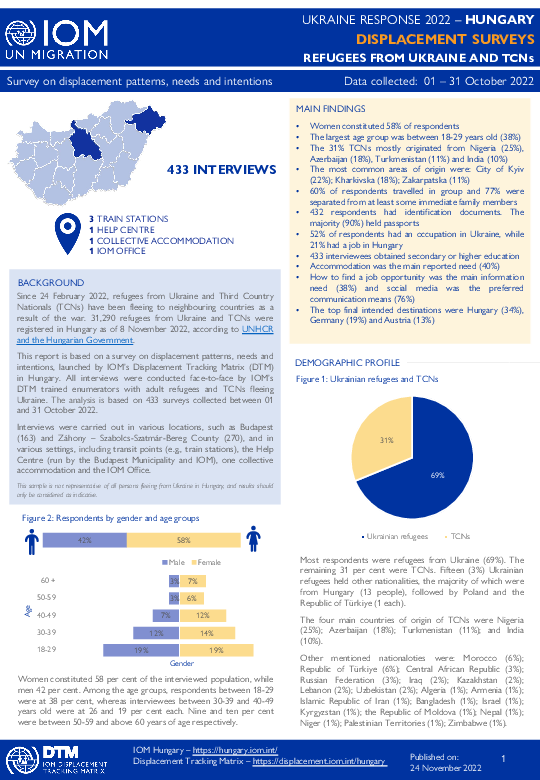
Contact
DTM Europe, DTMMediterranean@iom.int
Language
English
Location
Hungary
Period Covered
Oct 01 2022
Oct 31 2022
Activity
- Survey
- Flow Monitoring
Since 24 February 2022, refugees from Ukraine and Third Country Nationals (TCNs) have been fleeing to neighbouring countries as a result of the war. 31,290 refugees from Ukraine and TCNs were registered in Hungary as of 8 November 2022, according to UNHCR and the Hungarian Government. This report is based on a survey on displacement patterns, needs and intentions, launched by IOM’s Displacement Tracking Matrix (DTM) in Hungary. All interviews were conducted face-to-face by IOM’s DTM trained enumerators with adult refugees and TCNs fleeing Ukraine. The analysis is based on 433 surveys collected between 01 and 31 October 2022. Interviews were carried out in various locations, such as Budapest (163) and Záhony – Szabolcs-Szatmár-Bereg County (270), and in various settings, including transit points (e.g., train stations), the Help Centre (run by the Budapest Municipality and IOM), one collective accommodation and the IOM Office.

Contact
Regional Office Dakar, RODakar-DataResearch@iom.int, DTMBurkinaFaso@iom.int
Language
French
Location
Burkina Faso
Period Covered
Oct 05 2022
Oct 31 2022
Activity
- Flow Monitoring
L’OIM, a travers l’outil de Suivi des flux de populations (Flow Monitoring) de la Matrice de suivi des déplacements (DTM), récolte des données à des points d’entrée, de sortie et de transit clés, afin de mieux comprendre les mouvements de populations à travers l’Afrique de l’Ouest et du Centre. Le suivi des flux de population est une activité qui permet de quantifier et de qualifier les flux et tendances de mobilités, les profils des migrants, et les expériences et routes migratoires. Au Burkina Faso, des points de suivi des flux de populations (FMP) ont été progressivement installés sur plusieurs lieux de transit importants à Dori/Seytenga en février 2018, à Kantchari en mars 2018, ainsi qu'à Faramana et Yendéré en avril 2018 pour faire le suivi des flux migratoires dans le pays.
Au Burkina Faso, le suivi des flux de population se fait au niveau des quatre FMP et vise à mettre en lumière les zones particulièrement sujettes aux migrations transfrontalières et intrarégionales.
Ce rapport présente les données recueillies aux FMP du Burkina Faso en octobre 2022.

Contact
DTM Iraq, IraqDTM@iom.int
Language
English
Location
Iraq
Period Covered
Apr 01 2018
Jun 30 2022
Activity
- Mobility Tracking
- Baseline Assessment
From May 2018 to June 2022, 42,713 Iraqi returnees from abroad were identified in 17 Governorates, 73 Districts and 712 locations. During this reporting period, IOM Iraq achieved full country coverage.

Contact
DTM Iraq, IraqDTM@iom.int
Language
English
Location
Iraq
Period Covered
Jun 01 2022
Aug 31 2022
Activity
- Flow Monitoring Survey
DTM Iraq collects data at border crossing points with neighbouring countries – the Islamic Republic of Iran (Iran), the Syrian Arab Republic (Syria) and Türkiye – to better understand migration movements in the Middle East. Cross-border monitoring is designed to capture and describe migration flows. Data displayed in this report were collected employing two approaches: a headcount of all travellers entering or leaving Iraq and a survey of randomly selected travellers. Data collection took place between 1 June 2022 and 31 August 2022.
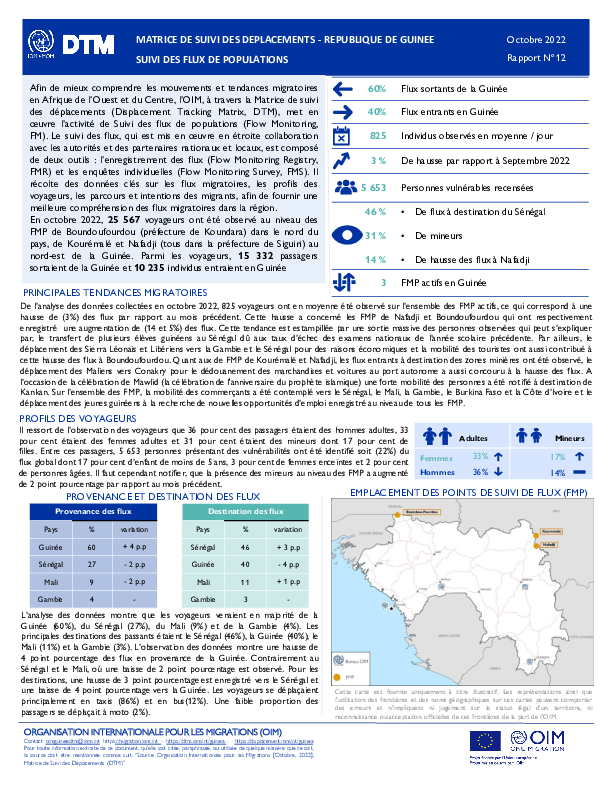
Contact
DTM Guinée, oimguineedtm@iom.int
Language
French
Location
Guinea
Period Covered
Oct 01 2022
Oct 31 2022
Activity
- Flow Monitoring
Afin de mieux comprendre les mouvements et tendances migratoires en Afrique de l’Ouest et du Centre, l’OIM, à travers la Matrice de suivi des déplacements (Displacement Tracking Matrix, DTM), met en œuvre l’activité de Suivi des flux de populations (Flow Monitoring, FM). Le suivi des flux, qui est mis en œuvre en étroite collaboration avec les autorités et des partenaires nationaux et locaux, est composé de deux outils : l’enregistrement des flux (Flow Monitoring Registry, FMR) et les enquêtes individuelles (Flow Monitoring Survey, FMS). Il récolte des données clés sur les flux migratoires, les profils des voyageurs, les parcours et intentions des migrants, afin de fournir une meilleure compréhension des flux migratoires dans la région.
En octobre 2022, 25 567 voyageurs ont été observé au niveau des FMP de Boundoufourdou (préfecture de Koundara) dans le nord du pays, de Kourémalé et Nafadji (tous dans la préfecture de Siguiri) au nord-est de la Guinée. Parmi les voyageurs, 15 332 passagers sortaient de la Guinée et 10 235 individus entraient en Guinée

Contact
DTM Iraq, IraqDTM@iom.int
Language
English
Location
Iraq
Period Covered
May 01 2018
Sep 30 2022
Activity
- Mobility Tracking
- Baseline Assessment
For the Return Dashboard the data was collected from May 2018 to September 2022. 44,637 Iraqi returnees from abroad were identified in 18 Governorates, 74 Districts and 714 locations. During this reporting period, IOM Iraq achieved full country coverage.
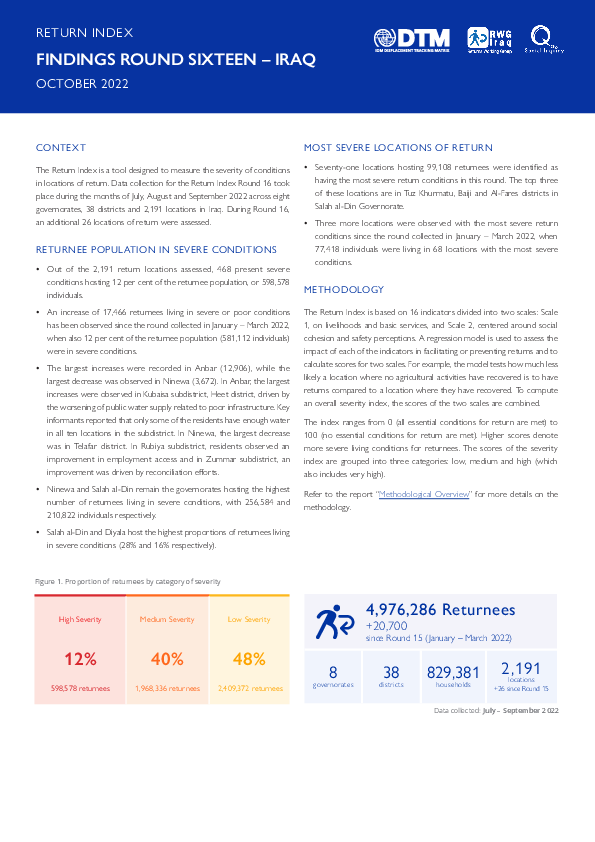
Contact
DTM Iraq, IraqDTM@iom.int
Language
English
Location
Iraq
Period Covered
Jul 01 2022
Sep 30 2022
Activity
- Survey
- Return Intention
- Mobility Tracking
- Baseline Assessment
The Return Index is a tool designed to measure the severity of conditions in locations of return. Data collection for the Return Index Round 16 took place during the months of July, August and September 2022 across eight governorates, 38 districts and 2,191 locations in Iraq. During Round 16, an additional 26 locations of return were assessed.

Contact
DTM Iraq, IraqDTM@iom.int
Language
English
Location
Iraq
Period Covered
Apr 01 2022
Jun 30 2022
Activity
- Survey
- Mobility Tracking
- Baseline Assessment
This report provides a detailed overview of the conditions faced by internally displaced persons (IDP) and returnee families residing in informal sites at the time of data collection of the Integrated Location Assessment 7 (ILA 7, April–June 2022). The ILA informal sites assessment was conducted in two parts. First, the location, population and shelter type of all informal sites were collected nationwide. Second, if the informal site had 15 or more families, a full assessment of the location was conducted, designed in partnership with the Cluster members of the Inter-Cluster Coordination Group (ICCG). In this report, data attributed to ‘fully assessed sites’ refer only to sites with 15 or more families.
The report concludes that families residing in informal sites face significant economic challenges impacting their ability to meet basic needs. Greater assistance and livelihoods programming are thus critical to support these groups. Additionally, the concerns surrounding water quality and waste collection highlighted in this assessment call for increased water, sanitation and hygiene (WASH) programming in informal sites. Despite the challenges of living in these sites, most families intend to remain in the short term and remain undecided about their intentions in the long term, which points to a need for greater durable solutions programming. More broadly, further assessments and monitoring of informal sites should be conducted to better understand conditions and emerging trends.